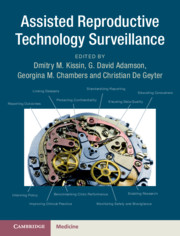Book contents
- Frontmatter
- Contents
- Foreword
- List of Contributors
- Section 1 Introduction to ART Surveillance
- Section 2 General Principles of ART Surveillance
- Section 3 Using ART Surveillance Data
- 5 Reporting ART Success Rates
- 6 Using ART Surveillance Data in Clinical Research
- 7 Monitoring ART Safety and Biovigilance
- 8 Quality Assurance of ART Practice: Using Data to Improve Clinical Care
- 9 Monitoring Long-Term Outcomes of ART: Linking ART Surveillance Data with Other Datasets
- 10 Use of ART Surveillance by People Experiencing Infertility
- Section 4 Global Variations in ART Surveillance
- Section 5 Surveillance of Non-ART Fertility Treatments
- Appendix A ART Surveillance System Variables and Definitions
- Appendix B International Glossary on Infertility and Fertility Care
- Appendix C ICMART Data Collection Form
- Index
- Plates
9 - Monitoring Long-Term Outcomes of ART: Linking ART Surveillance Data with Other Datasets
from Section 3 - Using ART Surveillance Data
Published online by Cambridge University Press: 14 June 2019
- Frontmatter
- Contents
- Foreword
- List of Contributors
- Section 1 Introduction to ART Surveillance
- Section 2 General Principles of ART Surveillance
- Section 3 Using ART Surveillance Data
- 5 Reporting ART Success Rates
- 6 Using ART Surveillance Data in Clinical Research
- 7 Monitoring ART Safety and Biovigilance
- 8 Quality Assurance of ART Practice: Using Data to Improve Clinical Care
- 9 Monitoring Long-Term Outcomes of ART: Linking ART Surveillance Data with Other Datasets
- 10 Use of ART Surveillance by People Experiencing Infertility
- Section 4 Global Variations in ART Surveillance
- Section 5 Surveillance of Non-ART Fertility Treatments
- Appendix A ART Surveillance System Variables and Definitions
- Appendix B International Glossary on Infertility and Fertility Care
- Appendix C ICMART Data Collection Form
- Index
- Plates
Summary
Infertility affects an estimated 80 million individuals worldwide, or 10–15% of couples of reproductive age. The number of assisted reproductive technology (ART) cycles in the United States more than doubled between 2000 and 2013. In 2015, about 1.7% of all live births in the United States were the result of this technology. In the US, studies of the long-term outcomes of ART involve the challenge of linking databases, in which one database has information on the treatment parameters, and the other database captures the outcomes of interest. This chapter discusses the linkage efforts, methodologies, and resulting research in the US by the Society for Assisted Reproductive Technology (SART) and the Centers for Disease Control and Prevention (CDC), and the health linkages routinely performed in the Nordic countries. Strengths and limitations of these approaches are also discussed.
- Type
- Chapter
- Information
- Assisted Reproductive Technology Surveillance , pp. 81 - 92Publisher: Cambridge University PressPrint publication year: 2019

